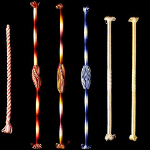Artifact: Doll with leading string

Materials: Wood, gesso, paint, linen
Dimensions: OL: 18"
Date: Early 18th Century
Origin: England
Collection: Image Courtesy of The Colonial Williamsburg Foundation
License: All rights reserved
Ledger Entry: Baby Doll

Department: Personal
Customer: Mrs. Jemina Minor
Ledger Page: 17
Imported From: Most dolls would have either been imported from England or produced in the colonies; however as fashion models, some dolls may have been imported from Paris as well.
Product Description
Dolls in the eighteenth century were primarily playthings, yet they also served as prescriptive devices to teach young girls. Though varying levels of sophistication and detail survive, dolls were equipped with the full range of clothing a person dressed in the same fashion would require including items such as stays, petticoats, and shoes. Dolls purchased with clothing often displayed the height of fashion and indeed may have begun life as scale models of new fashions. Dolls purchased without clothing may have served as a canvas for the girl to display her sewing abilities by constructing miniature clothing for the doll.
Citation: Leslie Reinhardt, "Serious Daughters: Dolls, Dress, and Female Virtue in the Eighteenth Century," American Art 20, no. 2 (Summer 2006): 32-55.;
Historical Price: 10 pence; Modern USD: $9.35
Product Variations
The databases record six purchases of babies which we interpret as baby dolls. Two of these dolls are identified as having glass eyes indicating a higher quality of doll than those with eyes merely painted on. The prices range from ten pence each for two babies to one pound eight shillings for a baby with glass eyes.






